
KIH
[Purist]
12044

Hublot Antikythera Watch
(Note: This is the translation of an article I wrote for the Japanese watch magazine - "World Wrist Watch", with its written permission. The article was written before Basel and therefore I made some modification.)
In October 2011, Hublot announced at Musée des Arts et Métiers in Paris a movement, "Antikythera", created by the completely unique approach. "Antikythera" movement - to be precise, it is a movement tribute to the ancient "machine" from the ancient Greek (between BC 1st and 2nd century). The name "Antikythera" itself is the name of an island northwest of Crete Island, and it was found in 1900 by the sponge divers among many other artifacts and relics apparently from the shipwreck nearby. The academic name of this "machine" is "Antikythera Mechanism" and it seems to still have lots of secrets inside and the Hublot movement announced at Basel is not intended to be the complete re-creation of the original one, but one can only imagine how hard it was to make it into such a small wrist watch size movement. Hublot has been leading the industry most notably in the case material with unique alloys under the "Fusion" concept, but with joining of Mr. Mathias Buttet and his team and equipment for the inside of the watch, it just started showing its new direction with last years novelties, MP-1 and MP-2. This "Antikythera" has been initiated and led by Mr. Buttet's team and was one of the most anticipated model of this year's Basel. This article tries to explain and report, first about "Antikythera Mechanism", and then the new "Antikythera" movement by Hublot team in detail.


With Yanis Bitsakis (see the interview below)

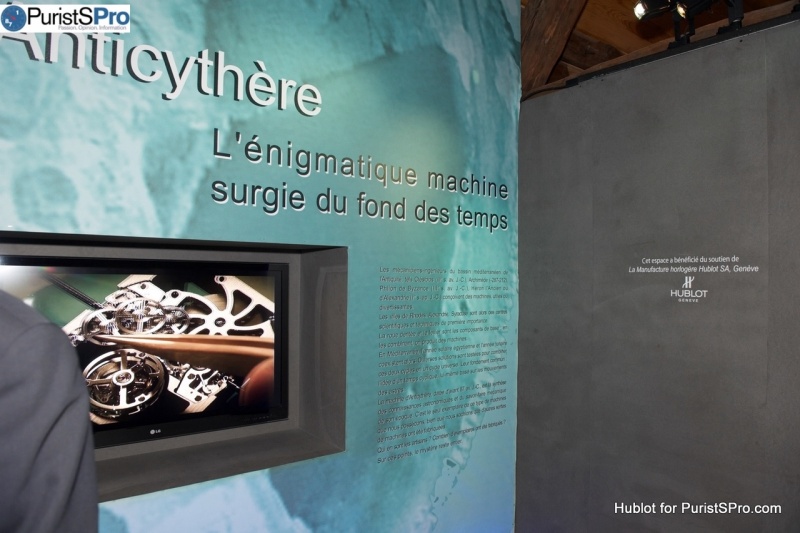


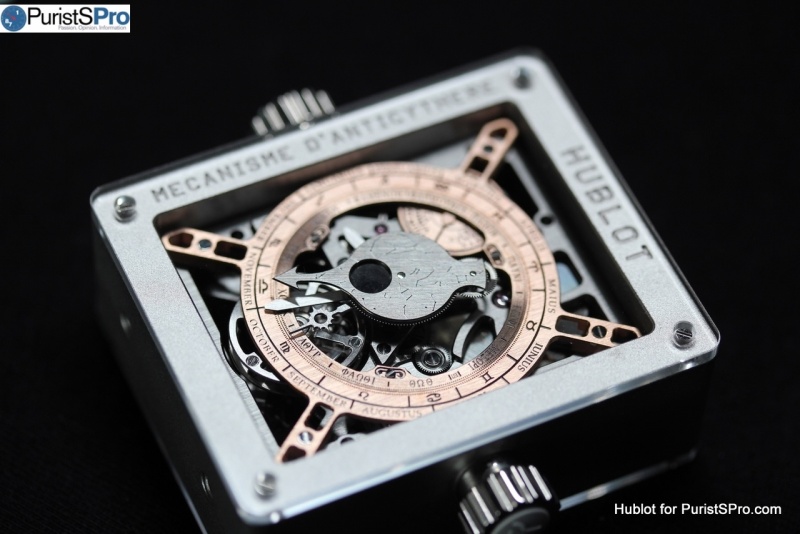
What is "Antikythera Mechanism"? - First of all, we need to know a bit more about the "Antikythera Mechanism". The research is still going on and the progress is made public on www.antikythera-mechanism.gr and if you are an archeology buff and want to follow more in detail, please refer to that site. A very intriguing website.
Discovery - Around at
the end of 1900, there was a ship which had to stop by the Antikythera
(the island) to let the storm pass during its voyage. While it had to
stay there, the crew decided to pass the time by sponge diving (note:
Sponge has been a very well-known product of Greek). At the depth of 40
to 60m, the divers found the shipwreck and some artifacts. Thanks to the
report from them, in 1901 the team including Greece Navy divers found
many various archaeologically high-value relics and artifacts. One of
them was the Antikythera Mechanism. It was found in 1901, but it was
left unstudied for half a century because the main weapon of the
archaeologists back then was imagination only and they could not open
Antikythera Mechanism - so their imagination could not go very far.
Antikythera sunset today....

Here is Antikythera

Antikythera back then...

The biggest fragment - they had little idea what it was until quite recently.

82 fragments in total.

The findings and what we think
we know so far - As a fact, it has been found out that (1)
this "machine" was created between BC 1st and 2nd century, and (2) this
was not a "clock" which displayed time, but more like an "analog
computer" which displayed the move of the celestial bodies in the sky.
There are more than 30 "gears" in the 33cm x 18cm box and the apparent
"instruction manual" is inscribed inside. This incredibly advanced
"machine" found in 82 fragments is permanently preserved in the National
Archeology Museum in Athens. In 2005, joint team of US, UK, and Germany
with the cooperation of some high-tech companies made it possible to
see through the "Antikythera Mechanism", just like the CT scan, with
tomograms of every 1/10mm thickness. The new findings are as followings:
Antikythera Mechanism is not a "clock" but a cosmograph or a
selenograph. The mechanism was so accurate that it could show multiple
astronomical cycles (to be explained later) and it even recognizes the
existence of the leap year and it could be adjusted every four years
(the first calendar - Julius Calendar - which included the leap year was
invented 100 years after Antikythera Mechanism). Other notable function
of the Mechanism are - the movement of Mars, Mercury, Zodiacal
constellations, moon phase, forecasting eclipse, 365 days calendar
(Egyptian calendar) and the day and place of the national game every
four years. It was a good thousand years ahead of the first astronomical
clocks in the Middle Ages.
One of the Scans....

The re-constructed "Antikythera Mechanism".

Who made it, where was it
made? - There are still various theory on this and no definite
answer yet. The most popular theory as of today is that it was designed
on Rhodes Island by the astronomers’ community including Hipparchus and
Posidonius. And the latest research indicates at least some involvement
of Archimedes in it. One thing the researchers do agree on is that this
machine was made in Greek, because the inscription (believed to be some
kind of instruction manual) was written in Koine, which is the ancient
Greek dialect.
Inscription which is apparently some sort
of "instruction manual". 
Hublot's Decision to Challenge
In 2008, Mathias Buttet was reading the
science magazine "Nature" to find about the tomographs of the
Antikythera Mechanism. He was so moved and decided to make the watch
based on this mechanism (see the interview section for details). He
aimed to make the movement, which not only copy the Mechanism, but also
with the time-telling function and his own interpretation of it into the
smaller size caliber.

Hublot Antikythera Caliber 2033-CH01 - what exactly does it do?
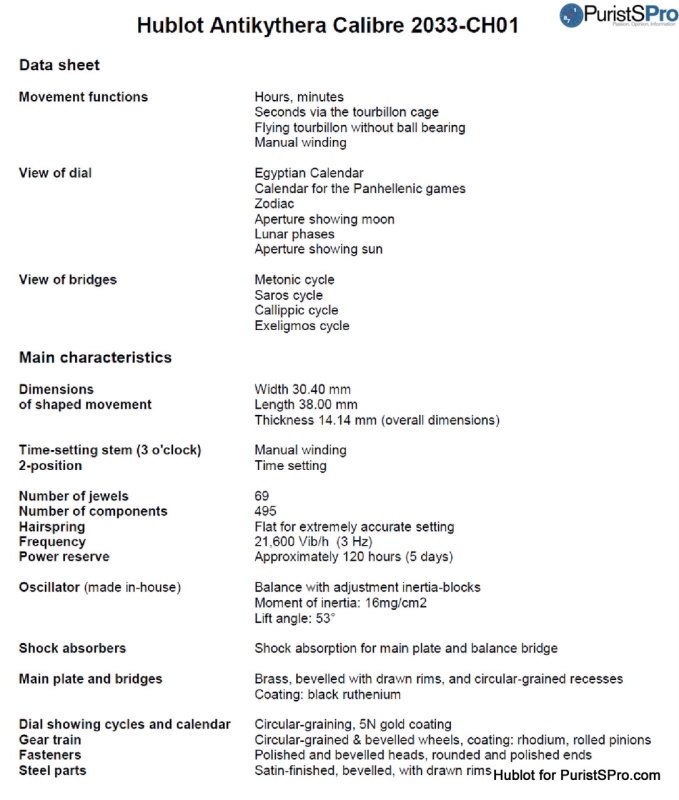
The specification was released by Hublot, but it doesn't tell us a lot. What exactly this caliber does, what kind of watch it will be..... I asked the man, Mr. Mathias Buttet;
What materials are used for the Antikythera movement?
It's true that it might seem strange for Hublot product connoisseurs that we didn't opt for high-tech materials, such as carbon fibre or ultra-light aluminum. At the beginning of the project, I intended to use bronze like the original Antikythera piece, but once we were immersed in the project we decided not to highlight the materials, but to let the mechanism take centre stage, with all the magic of its ingenuity.
The further the team
progressed in the study of the Mechanism, the more our respect for such
genius grew. So we used well-established materials, namely brass and
steel.

How many pieces will be made? To whom will they be offered?
The same respect for the
Mechanism that overwhelmed the engineering team has visibly "afflicted"
the Hublot management team. Indeed, in the same spirit, they decided
against putting these tributes to Ancient Greece on the
market
Just 4 pieces will be made. One will be donated to the
Athens Archaeological Museum, where the original Antikythera Mechanism
is exhibited (since April 4th 2012), another will be offered to the
Paris Museum of Arts and Crafts (a movement without an exterior has been
on display there since October 2011). A third piece will be kept in the
Hublot Collection (for our future Museum), and finally the fourth piece
will be auctioned off in 2012 (the exact date is not yet known), and
the proceeds will be distributed organisations that seek to preserve the
original Antikythera Mechanism, which we consider the most precious
item of Antique Mechanics.

What inspired you with the idea of a tribute to the Antikythera Mechanism, and when?
In Summer 2008 a scientific journal published an article on this subject, and upon reading it I realised that I had to spend time studying the Antikythera Mechanism. It is actually not just an astronomy mechanism, but something that calls into question the history of technology and its own history.
No mechanical adventure could give me more pleasure. Engineering schools teach us that our modern mechanics, our famous gears, originated during the Italian Renaissance, i.e. around 1500. When we were working on the Antikythera Mechanism, and began to discover that it was designed and made in approx. 150 B.C. and that the knowledge for displaying astronomic information dates from 500 B.C., we could not help but be fascinated by this enigma.
Furthermore, when we
managed to decode the incredible ingenuity shown by the Mechanism, such
as displaying and factoring into the calculations the non-linear speed
of the Moon, we could only bow down to such mastery, and I am delighted
to say that our forefathers in mechanics and engineering from Ancient
Greece would have nothing to envy in our modern mechanics and our
knowledge of gears. So the feeling among the whole team working on the
Antikythera Mechanism is divided between extreme happiness as they
reflect upon these Greek geniuses dating back to before Christ, while
lamenting the obscurantism that prevailed for 2000 years. The watchword
of the whole undertaking has been "Respect".
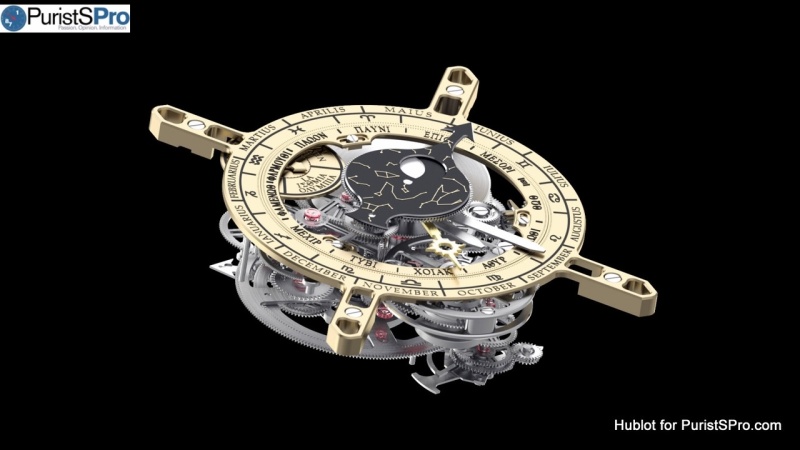
How did you find the experience of having to work with archaeologists and scientists, rather than just with horologists?
Since the beginning of the adventure, I could see that the archaeologists were not generally interested in mechanics, but rather by the object and its dating, as if they were using the archaeological object in a puzzle of the scale of time. Once the object, in our case the Antikythera Mechanism, had been dated, it was no longer something of genuine interest for an archaeologist. Fortunately, at the outset of this adventure, I met a researcher, Yanis Bitsakis, an enthusiast of the Antikythera Mechanism, with a background in physics and the History of Science, who is part of a research group formed for the Antikythera Mechanism.
Yanis and his team had
already done brilliant work, and so they had already had to blow away
the cobwebs that could be found in the museums and in the minds of some
archaeologists. I can now say with certainty that I have gone through
the most enriching horological adventure of my career thanks to my
acquaintance with the Mechanism and with Yanis. He has become a true
friend, and we are planning the next phase together, since the
Antikythera Mechanism has not yet given up all its secrets.

What difficulties were encountered in the design / manufacture of the Antikythera?
As a horological designer with over twenty years' experience, I know that when we want to describe the Moon, we use mechanisms such as the perpetual calendar or moon phase indicator, and to this end we open a good old horological book and look up the gear formulas used for centuries (horology has its cobwebs too!); whereas for the miniaturisation design of the Antikythera Mechanism, far more accurate explanations were needed, the origins of which go back beyond 500 B.C. For example, I now know that the full moon that I see in my garden will come back to the same place after 235 full moons, i.e. in 19 years: this is the Metonic cycle, one of those indicated by the Antikythera Mechanism.
In terms of the
mechanism, modern horologists do not factor in the speed of the Moon
through our sky. The Antikythera Mechanism controls the elliptical
trajectory of the Moon by means of differential gears. Understanding
these took several months, and it isn't always easy to acknowledge that
our ancestors had such a level of mechanical knowledge.



================================================================
With these efforts and behind-the-scene
episodes, the miniaturized Antikythera mechanism contains 495
components, including 69 jewels, measuring 38 x 30 mm and 14 mm thick.
The mechanism controls 13 indicators including the time, 10 of which are
the original astronomical functions of the Antikythera
Mechanism.




The final watch has been released to the
public at the Baselworld 2012. I would very much love to see and handle
it myself, but it will go and stay where it belongs - museums and a
lucky auction winner from which various institutions benefit for the
research of this ancient machine - and I am happy about it. Maybe I can,
when I visit Hublot manufacture one day…. This is really a dream watch
of one watchmaker and kudos to Hublot for having made it happen.

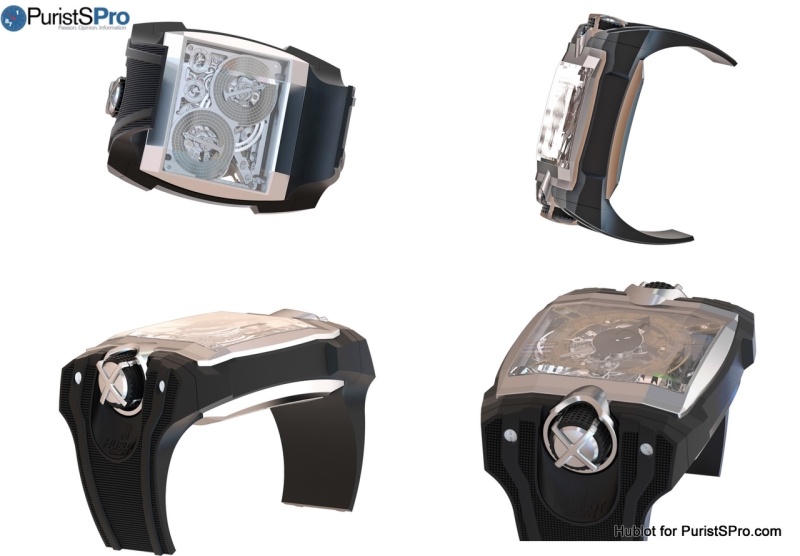
Live pics by foversta
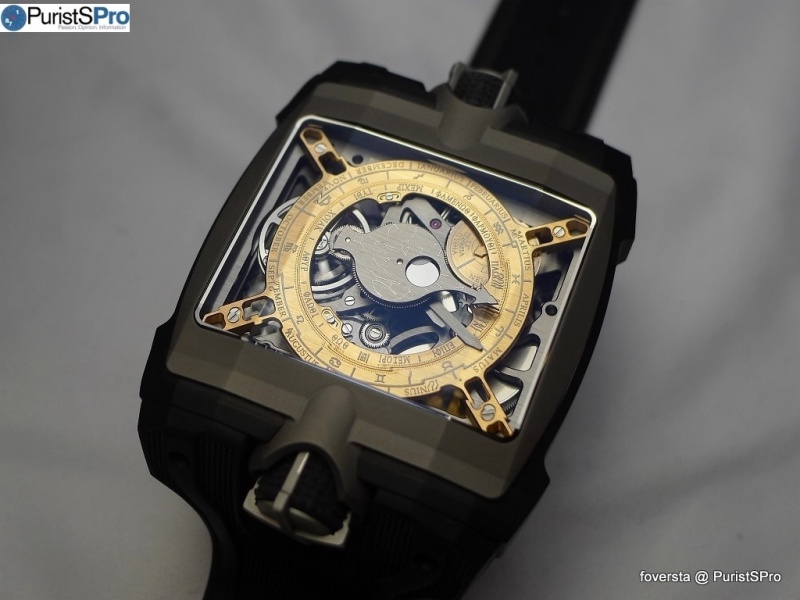
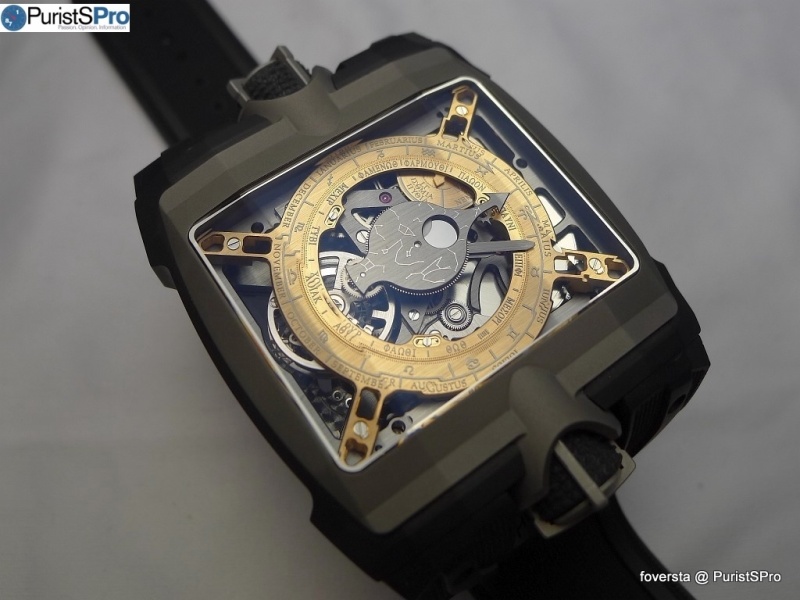
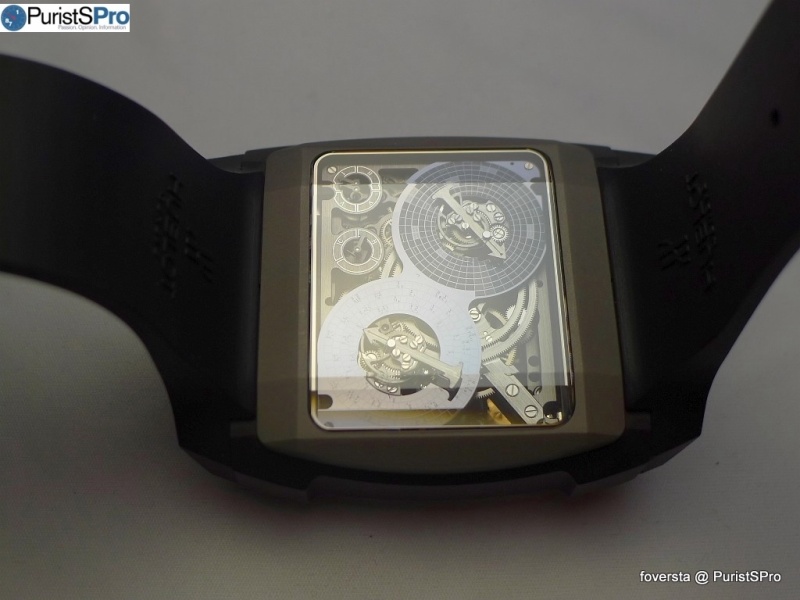

Special Thanks to:
Mr. Mathias Buttet - Hublot head of R&D
Mr. Amr Sindi - Hublot PR (Switzerland)
Ms. Mako Nakai - Hublot PR (Japan)
Ms. Tomoko Kayama - Editor in Chief : "World Wrist Watch" by World Photo Press.
Thank you very much for reading through!
Ken
Copyright
March 2012 - Ken Hokugo & PuristSPro.com - all rights reserved
(The Original Article in
Japanese was published on "World Wrist Watch" No.111 published by World
Photo Press, Tokyo, Japan)
Comments, suggestions, and
corrections to this article are welcome.

